While there were plenty of things happening in life, I had been less than diligent in documenting them down. During my absence from this blog, I had met up some of my very good friends, enjoyed my family life, celebrated my birthday and my very best friend's. Yes today is his birthday, Happy Birthday 发发! Welcome to the club! That is, the club of Thirties. And hopefully soon, I will welcome you to the club of married men and... :p That's a story for another day for now.
During the Good Friday weekend, I visited the "Treasury of the World" exhibition at Asian Civilisation Museum with my dear wife. The exhibition featured over 400 pieces of Mughal jewellery from the al-Sabah collection, Kuwait. It was assembled over the last four decades by Sheikh Nasser Sabah al-Ahmad al-Sabah and Sheikha Hussahh Sabah al-Salim al-Sabah of Kuwait. It is one of the world's greatest collections of Islamic art.

The history aside, now that the exhibition is coming to an end soon, here are some of the highlights! The mystic of the Mughal revealed... with descriptions and texts from the exhibition itself. :p
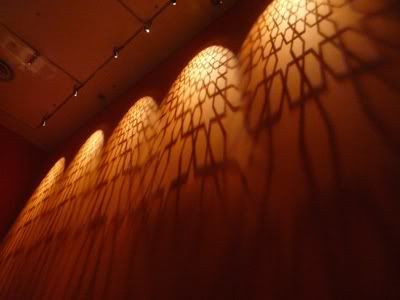

Food was traditionally served in vessels of gold, silver, earthenware, porcelain and jade. Jade was believed to act as an antidote, or to react to the presence of poison.

This dagger is believed to have been commissioned and designed by emperor Jahangir around 1619 in his imperial workshops. It is elegantly set with rubies to form patterns of birds and flowers.
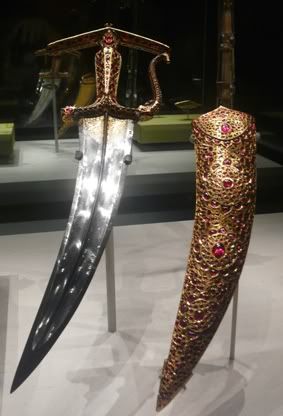
Board games such as Pachisi were played using cowrie shells as gamme pieces. These pieces were probably used as dice, with the value of the throw determined by whether they land face up or down. This set is exquisitely enamelled with variations of birds on each shell.
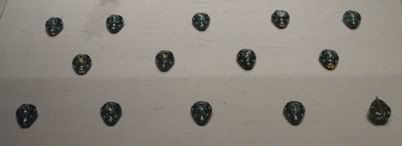
Smoking a huqqa (water-pipe) was traditionally offered to guests as a mark of hospitality. The mouthpieces were removable and were not shared by smokers. Artisans created luxurious gem-set and enaamelled pieces like these for wealthy patrons.
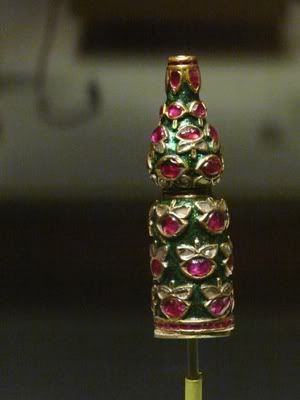
Description: India, Deccan, probably Hyderabad, late 17th-18th century. Fabricated from gold, champleve-enamelled, set in kundan technqiue with diamonds and rubies.
Beautifying the holy book was considered an act of devotion. Qur'ans were often given as gifts to and from the Mughal emperor. Some of them would be luxuriously decorated with gems and enamels.
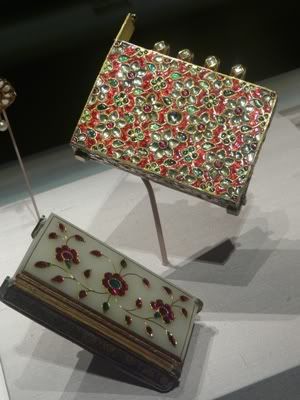
Description: India, Deccan or Mughal dated 1674-1675 CE. Manuscript inscribed in black ink on paper, illumination in ink, gold and colours; binding slabs of nephrite jade (white, with slight greyish cast), inlaid with gold and set in kundan technique with rubies and emeralds, the leather spine painted in gold.
The emperors used a variety of weapons for hunting, including bows, swoords aand rifles. Archery rings were used to protect the thumb when plucking the bowstring. The emperors often wore several archery rings on a sash as accessories.
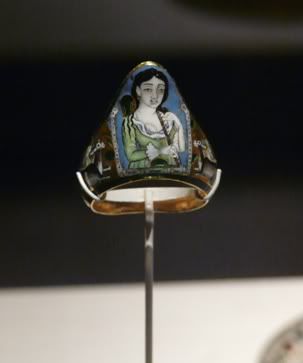
Description: India, probably Deccan, perhaps Bidar, 16th-early 17th century. Fabricated from gold; champleve-enamelled (encrusted), set in kundan technique with rubies and turquoises.
The Hindu influence on Mughal jewelled art can be seen on this gemset armband depicting a gopi (cow herdess) and Krishna playing a flute on the back of a cow.
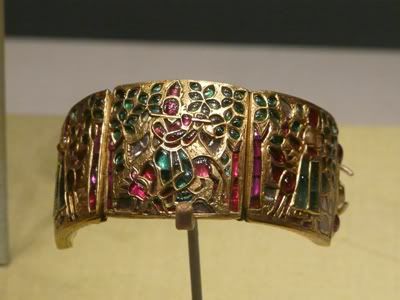
Description: India, probably Mughal, c. 1620-40. Fabricated from gold; worked in kundan technique and set with rubies, emeralds, diamonds and yellow sapphires; engraved and chiselled; interior of plain gold sheet.
Finger ring with rotating and bobbing bird.
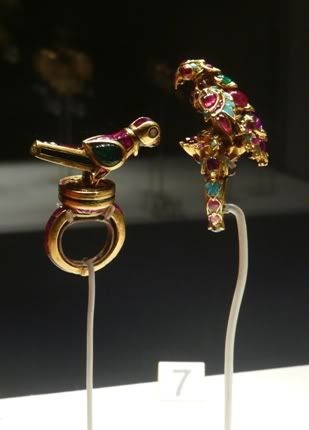
Description: India, Mughal or Deccan, probably c. 1st quarter 17th century. Fabricated from gold, set in kundan technique with rubbies, emeralds, chrysoberyl cat's eyes, diamonds and a single sapphire.
A golden pot of some sort...

Dear wife trying on the turban!
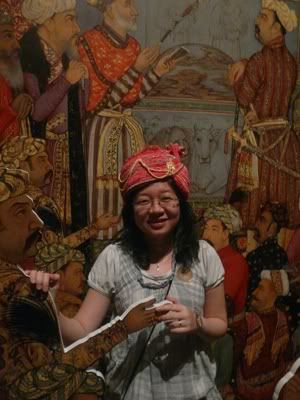
And finally, the royal spinel (Balas ruby)...
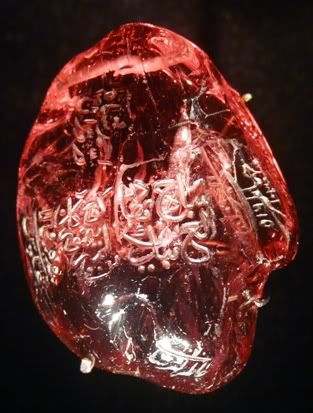
Description: The majestic stone can fairly be stated to be the most important inscribed gem known. Its earliest inscription, with the name of the Timurid sultan Ulugh Beg, predates the next oldest such inscription by 114 years. The only example with an inscription of a Timurid ruler, it is also the sole example with an inscription of a Safavid monarch. The stone and the necklace-centerpiece spinel of Her Majesty the Queen of England share the distinctionn among inscribed gemstones for the second-largest number of such inscriptions, totalling six in each case; the National Jewels Treasury of Iran alone preserves on with seven inscriptions. Additionally, the stone was famous in comtemporary society and literature before, during and after its dispatch as a gift from the Safavid Shah 'Abbase the Great of Iran to the Maghal emperor Jahangir in 1621.
So there you go, the treasures of the Mughals... The exhibition will be on till the 27th June 2010. So remember to catch it! =)
Comments